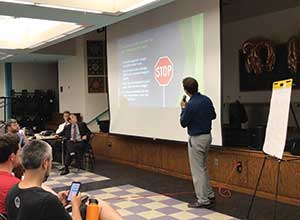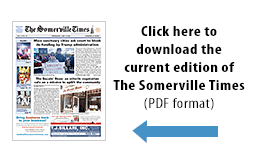
City staff updated the public on the current state of planning for construction of traffic mitigation and safety measures for Powder House Blvd.
By Jim Clark
The City of Somerville held a community meeting at the West Somerville Neighborhood School where developments in the planning and implementation of construction plans for Powder House Blvd. were presented to the public.
The meeting included a brief presentation with construction updates, parking study results, questions about the temporary, short-term solution to stripe a bike lane in one direction on a portion of the Boulevard, and the completion of traffic calming measures this summer.
The presentation was prepared by George Proakis, Executive Director of OSPCD, Brad Rawson, Director of Mobility, Adam Polinski, Transportation Analyst, Brian Postlewaite, Assistant Director of Engineering, and Toby Berkman, The Consensus Building Institute.
Updates on the progress of construction activities included the following:
- Sidewalk reconstruction and paving have been completed.
- Three new radar feedback signs have been installed along the Boulevard.
- The Curtis St 4-way stop pilot was rescheduled for August, following the suggestion for the trial to begin while school is out. The stop signs were expected to go in this month, remaining bagged until crosswalks and stop bars are put down, at which time the 4-way stop pilot starts.
Somerville’s first asphalt speed humps will be installed outside the school. It was reported that that the rubber speed tables were a success.
The city expects to take advantage of the current contract with the company that paved the Boulevard, and permanent humps will be installed where the rubber tables were. These were expected to be constructed in the first 2–3 weeks in August.
The HAWK signal at the school entrance is still under review. The final design at Hardan Rd. is dependent on the success of Curtis St. pilot, the effect of permanent speed humps on behavior at crosswalks, and the evaluation of local HAWK signal implementation.
If any changes need to be made, they will be discussed at the next community meeting. If not, design of HAWK signal will begin in earnest.
It was further reported that city staff have reviewed handouts and an online survey from the last meeting and the results were discussed in detail.
In the presentation, it was stressed that the City of Somerville is committed to a number of transportation and community goals and has already been working to provide safer facilities while balancing on-street parking needs.
As a next step, while the community process continues, a temporary bike lane will be painted in one direction to provide traffic calming and improved bike facilities in the interim.
In response to the question of why the street has to be striped as soon as possible, it was pointed out that speeds are decidedly higher when travel lanes are wider, and in order to reduce vehicle speeds and improve safety, the boulevard must be striped as soon as possible. This paint will fade over the course of the next 12 months, allowing for the opportunity to change the design.
The presentation acknowledged that the community process needs to continue to determine best solution for the Boulevard. That stakeholders have raised a number of questions that still need to be answered before additional changes can be made, such as:
- How will parking and curb use needs be addressed?
- Which protected bike lane concept is the safer option?
- What happens at intersections?
- How does Broadway fit into the mobility discussion?
An additional next step consists of the continued study of parking. The city has collected some initial parking data for the Boulevard, which is now posted on the Powder House Boulevard Planning web page.
The follow-up study will be in the fall when Tufts is in session. This will also allow staff to collect data on nearby streets to better understand parking demand across a larger portion of the neighborhood and will fold into citywide parking study, which is being developed now.
According to the points addressed in the presentation, working with neighborhood institutions to address unique transportation and parking needs is important.
Investigation of parking mitigation strategies will be examined. Specifically, how the unique needs of neighborhood institutions will be addressed. This includes Doherty’s, the Presbyterian Church, the Open Center, the Nave Gallery, the West Somerville Neighborhood School, SHA Clarendon Hill, Triangle Field users, and others. Also, what happens in special cases such as street sweeping, snow emergencies, or large Tufts events.
The city further plans to continue developing new design options and testing different cross sections. One alternative includes switching the parking lane and bike lane.
The city also plans to expand the conversation to include a larger portion of the neighborhood. According to planners, a unique street network, a variety of destinations, and upcoming resurfacing projects underscore the need to think more holistically about the neighborhood.
The next community meeting will be in Fall 2019. The city says it will have data, study results, and possible solutions for the questions that were raised in the last meeting.

 https://www.portersquarebooks.com/
https://www.portersquarebooks.com/













Curious. How do speed bumps affect ambulances and police emergency response?